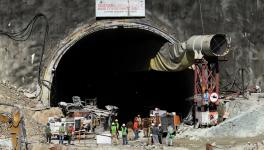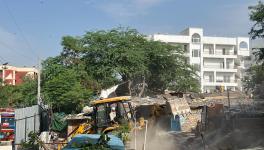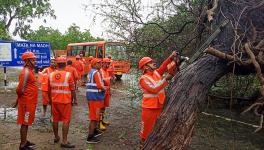Still No Trace of 13 Trapped Miners From Meghalaya

Five days after 13 coal miners (some have put the figure at 17) were trapped in a collapsed mine in Ksan village of Meghalaya’s East Jaintia Hills district, the National Disaster Response Force (NDRF), State Disaster Response Force (SDRF) and the local police have failed to find any trace of the miners so far.
The district administration of East Jaintia Hills is contemplating to seek help from the Oil and National Gas Corporation (ONGC).
Having about 650 million tonnes of coal reserves, this multi-crore business with links across several states in the country, and in Bangladesh, is allegedly funded by high-profile politicians and businessmen.
Alleging that coal mining has resulted in pollution of the Kopili River, the Assam-based All Dimasa Students’ Union from the Dima Hasao District had filed a petition against rat-hole mining, following which, the NGT clamped a ban on the activity on April 17, 2014. However, after protests by the mining lobby, the Tribunal had allowed the transport of the already-mined coal.
Despite the four-year-old ban on the rat-hole mining in the state by the National Green Tribunal (NGT), the illegal activity is functional in full view, owing to the loophole that allowed the transportation of already mined coal. The state government had further challenged the NGT ban in the Supreme Court in November this year, leading to the extension of the transportation deadline till January 31, 2019.
“The extension of the transportation deadline since 2014 has meant that in the name of transport, mining is being done here. Even the workers who are currently trapped now in East Jaintia left some two weeks back to work in the mines. This is around the time the Supreme Court allowed an extension on the coal transportation deadline,” a Meghalaya-based source told Down To Earth, on the condition of anonymity.
Silvester Nongtyngnger, the East Jaintia Hills superintendent of police said that the mine where the 13 miners are trapped is 370 feet deep. He said, “It is in fact below the water level of the adjacent Lytein River, so you can well imagine the challenges we are facing to drain out the water.”
The coal mine owner Jrin Chullet a.k.a. Krip Chullet, was arrested on Friday night from Narwan village. Nongtyngnger said, “He and anyone else involved will not be spared, I assure you.”
On November 8, two activists, Agnes Kharshiing and Amita Sangma, while recording the transport of coal from an illegal coal mine, were allegedly attacked by a few men working for the mafia. Earlier this year, on March 19, RTI activist and former president of the Jaiñtia Youth Federation, Poipynhun Majaw, was found murdered at Khliehriat, the district headquarters of East Jaintia Hills.
When asked whether the instigator of the November 8 attack, Nidamon Chullet, was related to the owner of the mine, Nongtyngnger said that they may be of the same clan, however, investigations are still underway.
The Comptroller and Auditor General of India (CAG) also released a report on the revenue sector of the state, pointing out the difference in the revenue of Rs 46 crore resulting from the under-reporting of coal exported to Bangladesh. The audit also observed that there was no system in place in the Mining Department for cross-verification and reconciliation of figures.
It was also pointed out that the mine owners have not paid the royalties to the District Mining Officer (DMO). The report described that the royalty worth Rs. 51.78 crore has not been realised on 7.67 lakh MT of coal, but despite having this information, the DMO has not initiated any action, says the report.
Illegal mining in the state has led to many incidents resulting in the death of the labourers. In February 2014, four miners were killed when the walls of an illegal mine in the Garo hills had collapsed. In December 2013, five miners died due to the snapping of the cable of a basket carrying them.
On the morning of December 13, the 370 feet deep mine was flooded by a nearby river, resulting in trapping of the miners. Even as the 13 miners are presumed dead, the Union Coal Ministry has, under review, a formal proposal sent by the National People’s Party-BJP government, seeking a way around the ban. The next hearing regarding the matter is scheduled for January 15, 2019.
Get the latest reports & analysis with people's perspective on Protests, movements & deep analytical videos, discussions of the current affairs in your Telegram app. Subscribe to NewsClick's Telegram channel & get Real-Time updates on stories, as they get published on our website.
























